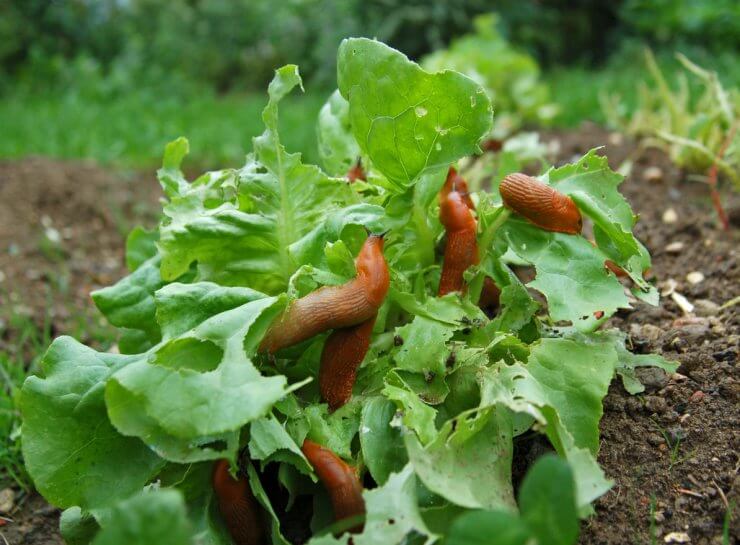
Snails invading a lettuce plant
Pests on your lettuce plants, left unchecked, can damage and destroy your lovely lettuce. Keeping a close watch on your lettuce during regular daily inspections will help you spot any pests before they can do irreparable harm.
Spot the symptoms of lettuce pests
Check your lettuce leaves for these symptoms that come from pests on the prowl.
On Lettuce Leaves
| Symptom | Pest |
|---|---|
| Symmetrical holes in Leaves | Tarnished plant bug |
| Winding trail scars on the leaves | Leafminers |
| Yellowing leaves; clusters of small “bumps” on underside of leaves | Aphids |
| Tiny waxy-looking clusters | Mealybugs, whitefly eggs and larvae, Leafhopper larvae |
| Ragged holes in leaves | Cabbage looper, slugs |
| Honeydew on leaves | Whitefly |
| Chewed, broken stems | Cutworms |
How to treat pests on lettuce plants
Here are some proven ways to get rid of pests on your lettuce plants. Choose the best treatment for the type of pests invading your lettuce.
- Pick off the pests. Use your garden gloves to remove the pests by hand. After removal, destroy pests by drowning them in a bucket of soapy water or crushing them with your foot. Handpicking isn’t efficient or practical for very small pests, but works well with larger pests.
- Discard/destroy damaged leaves. Once a pest has been munching on your lettuce leaves, or snails have left a trail of mucus behind, it’s time to cut the leaves off and get rid of them.
- Apply insecticidal soap. Insecticidal soap is organic. The potassium salts in insecticidal soap help remove an insect’s protective waxes, causing destruction of insect membranes and killing them. Mix the soap with water to create your solution, and apply directly to insects on any plants. While insecticidal soap is less apt to affect other organisms, certain plants might be sensitive to the soap and can suffer leaf burn.
- Apply horticultural oils. Combine plant- or petroleum-based oils with water to produce horticultural sprays. Neem oil, for instance, is derived from seed extracts of the neem plant. Oil-based sprays block an insect’s air holes, interfere with an insect’s metabolism, disrupt insect feeding, and inhibit insect growth. Like insecticidal soaps, horticultural oils can cause plant injury if not properly diluted.
- Make your own pest spray. You can make your own pest spray with benign materials. Mix 1 tablespoon of baking soda, 1/2 teaspoon of a mild dish detergent, and 2 1/2 tablespoons of olive oil in a gallon of water to make a solution that will repel all kinds of bugs, as well as a fungicide for blight and mildew on lettuce plant leaves. Shake it well in your bottle before spraying and repeat every week for it to be continuously effective.
- Diatomaceous earth. Some gardeners swear by the use of DE, as it’s commonly known. Diatomaceous earth is the pulverized fossils of ancient diatoms—tiny prehistoric sea creatures. Even when ground into a powder, these microscopic skeletal pieces have sharp edges that irritate the respiratory systems of insects and dry out the mucous membranes of breathing holes and lungs in insects. And all those sharp edges spell danger for any soft-bodied creatures, such as snails or larvae. It must be applied when conditions are dry, and you need to reapply it after a heavy rain or even a heavy dew. And be sure to get food-grade DE; it’s safe around pets and people.
- Traps. For slugs, you can set out boards or damp burlap bags as traps in the evening. Check underneath in the morning, where the slugs will have gone to sleep for the day. You can also try the old beer-in-a-bowl remedy and see how many slugs you can catch. For flying pests, a yellow pest strip can attract pests to its sticky surface.
- Companion planting. Plant garlic or chives to deter aphids. Plant alyssum: it attracts syrphid flies, which love to eat aphids.
Do pests attack your lettuce plants every year? How do you handle removing them—and even preventing them in the first place? Please tell us how you treat your lettuce plants to avoid pests.


 Previous
Previous

